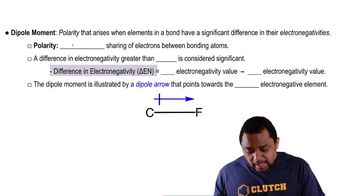Textbook Question
(b) It turns out that ozone, O3, has a small dipole moment. How is this possible, given that all the atoms are the same?
1
views
 Verified step by step guidance
Verified step by step guidance



(b) It turns out that ozone, O3, has a small dipole moment. How is this possible, given that all the atoms are the same?
(b) If you react BF3 to make the ion BF32-, is this ion planar?
(c) Does the molecule BF2Cl have a dipole moment?
Predict whether each of the following molecules is polar or nonpolar: (a) IF, (b) CS2, (c) SO3, (d) PCl3, (e) SF6, (f) IF5.
Predict whether each of the following molecules is polar or nonpolar: (a) CCl4, (b) NH3, (c) SF4, (d) XeF4, (e) CH3Br, (f) GaH3.
Dichloroethylene (C2H2Cl2) has three forms (isomers), each of which is a different substance. (b) Which of these isomers has a zero dipole moment?